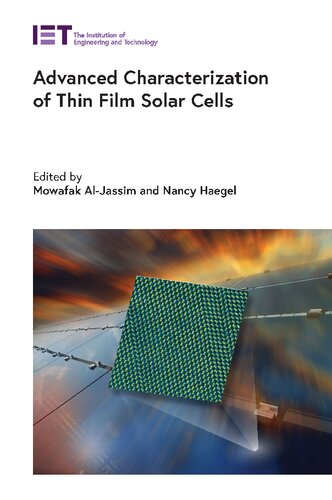

Most ebook files are in PDF format, so you can easily read them using various software such as Foxit Reader or directly on the Google Chrome browser.
Some ebook files are released by publishers in other formats such as .awz, .mobi, .epub, .fb2, etc. You may need to install specific software to read these formats on mobile/PC, such as Calibre.
Please read the tutorial at this link: https://ebookbell.com/faq
We offer FREE conversion to the popular formats you request; however, this may take some time. Therefore, right after payment, please email us, and we will try to provide the service as quickly as possible.
For some exceptional file formats or broken links (if any), please refrain from opening any disputes. Instead, email us first, and we will try to assist within a maximum of 6 hours.
EbookBell Team

0.0
0 reviewsPolycrystalline thin-film solar cells have reached a levelized cost of energy that is competitive with all other sources of electricity. The technology has significantly improved in recent years, with laboratory cell efficiencies for cadmium telluride (CdTe), perovskites, and copper indium gallium diselenide (CIGS) each exceeding 22 percent. Both CdTe and CIGS solar panels are now produced at the gigawatt scale. However, there are ongoing challenges, including the continued need to improve performance and stability while reducing cost. Advancing polycrystalline solar cell technology demands an in-depth understanding of efficiency, scaling, and degradation mechanisms, which requires sophisticated characterization methods. These methods will enable researchers and manufacturers to improve future solar modules and systems.
This work provides researchers with a concise overview of the status of thin-film solar cell technology and characterization. Chapters describe material systems and their properties and then provide an in-depth look at relevant characterization methods and the learning facilitated by each of these.
Following an introductory chapter, the book provides systematic and thorough coverage of the following topics: trends to improve CdTe solar cell performance; C (In,Ga)Se2 and related materials; perovskite solar cells; photovoltaic device modelling; luminescence and thermal imaging of thin-film photovoltaic materials, devices, and modules; application of spatially resolved spectroscopy characterization techniques on Cu2ZnSnSe4 solar cells; time-resolved photoluminescence characterization of polycrystalline thin-film solar cells; fundamentals of electrical material and device spectroscopies applied to thin-film polycrystalline chalcogenide solar cells; nanometer-scale characterization of thin-film solar cells by atomic force microscopy-based electrical probes; scanning transmission electron microscopy characterization of solar cells; photoelectron spectroscopy methods in solar cell research; time-of-flight secondary-ion mass spectrometry and atom probe tomography; and solid-state nuclear magnetic resonance characterization for photovoltaic applications. The final chapter provides an overview and describes future prospects.